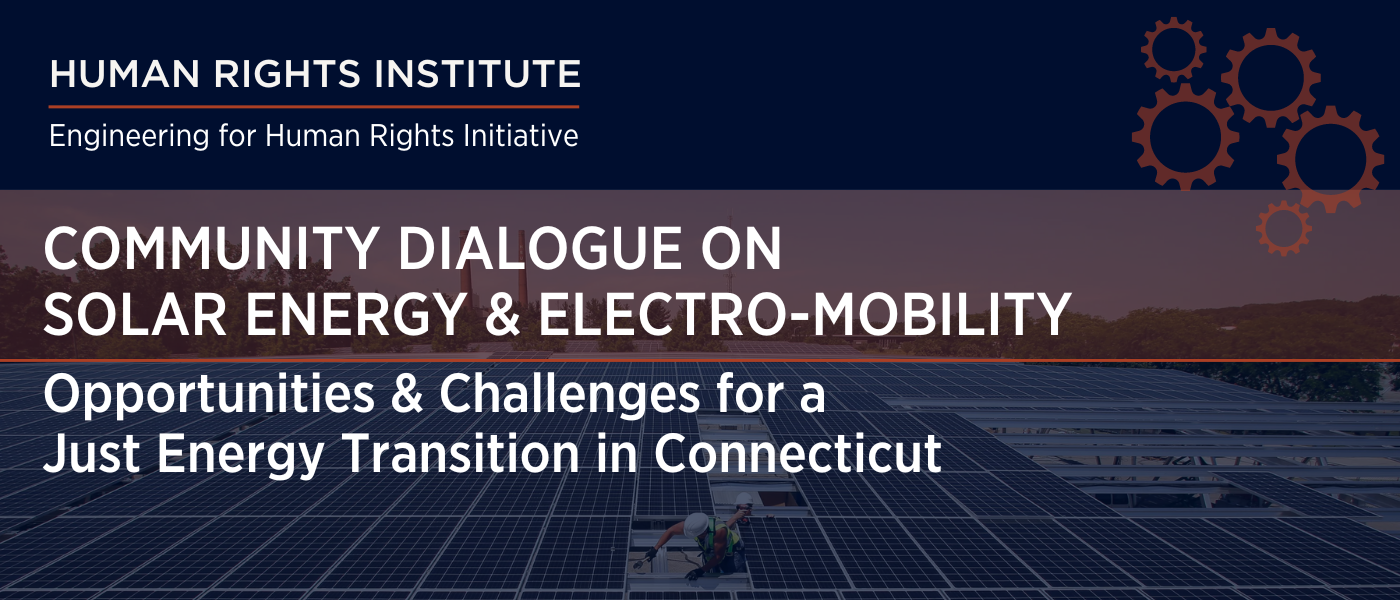
Clean energy has become one of the key strategies to mitigate and reduce the effects of climate change, reduce oil dependency, improve the quality of our environment, and reduce household expenses on energy. However, the benefits from energy production and distribution have not been equally experienced by all communities. And the negative social and environmental consequences have not been equally shouldered. The clean energy transition may be an opportunity to redress some of those inequalities.
This event was aimed at fostering dialogue among community representatives, researchers, and policymakers interested in the equity implications of solar energy and electric mobility. We explored the sustainability and human rights challenges and opportunities that the clean energy revolution might bring to these sectors.
Summary of the event
The Engineering for Human Rights Initiative hosted a hybrid “Community Dialogue on Solar Energy & Electro-Mobility” on February 1, 2023, at the UConn Storrs campus (Connecticut). The event was attended by community members, energy advocates, students and interested faculty from across the state. The discussion centered on the economics of energy justice amidst the transition to clean energy, including education and extension, accessibility, and equity dimensions. This event was a step toward building university-community partnerships for research and partnership in renewable energy, affordable transportation, and equitable access to emerging technologies for Connecticut residents.
Key Takeaways (click for shareable PDF version)
- Education and extension – How can UConn support communities on clean energy technologies and assist them in accessing capacity-building/implementation grants or other support for these technologies
- Mapping key stakeholders that make the change and transition to clean energy fair for everyone. These include, but are not limited to, policymakers, energy generators and providers, local officials, worship places, and community representatives, among others. It is also important to identify locations for community connections that are “trusted” and easy to access (for example, a local barber shops). What factors help build influence community trust?
- Analyze the intersectionality of different factors such as housing (multi-family housing, renters, etc.) and infrastructure & services (e.g., transportation) and how they are linked to environmental justice in Connecticut. Does addressing energy justice need to address environmental justice issues first? What is the interdependence between the two? How does infrastructure and technology play a role in linking both of them?
- Explore the “economics of energy justice” as the economic impact of fair access to clean energy needs to be measured, as well as the role of incentives that could facilitate that transition. The disadvantages of communities without adequate access to energy are denied the opportunity for economic development, and that missed opportunity could also be quantified. What are the incentives for owners and renters that could promote the transition to clean energy?
Discussion Summary
Dr. Lyle Scruggs (University of Connecticut, Dept. of Political Science) presented on the rollout of rooftop solar panels ongoing throughout Connecticut. Scruggs highlighted the size and location of projects, noting that there are many underserved communities which may not have the resources to adopt solar panel technology. Scruggs focused, in particular, on the electoral implications of renewable energy adoption at the local, state, and national levels (i.e., analyzing the connection between adoption and those who hold positions in office). Together with others involved in the dialogue event, Scruggs explored factors affecting access to renewable energy (including shared housing) as well as the lack of access for the public to information on financial incentives and policies; discussion also focused on whose responsibility it is to help reach these communities. Participants discussed a potential role for UConn in providing public information/outreach on energy incentives; whether it be the role of higher education institutions or the company’s responsibility, there was a consensus that there needs to be work done in this area to connect individuals with sound data on renewable energy programs. Depending upon the community, the message that adopting solar panels and more sustainable energy options is possible should come from a leader who the community trusts (including religious leaders, library staff, public educators or community officials).
Transportation incentives across the state were also discussed. One attendee noted the positive impact of a free bus program in New Haven that has helped the city address transportation needs. Another participant noted a program in Hartford that enables residents to use electric bicycles or scooters; rideshare programs also provide individuals with options for commuting. Planners should consider safe storage for electric scooters, especially for renters. The disproportionate impact of vehicle emissions by commuters in urban areas was discussed, along with the need to encourage public transportation use more broadly in light of environmental and health impacts. In this connection, the transportation goal should not necessarily be to electrify first but rather, to reduce vehicle miles traveled by the individuals through greater use of public transportation. Using public transportation rather than driving a single occupancy car was framed as a service to others and the environment. For a synthesis, see the handout above, “Key Takeaways.”